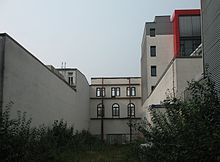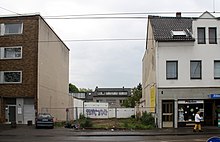Vacant lot
Vacant lots are areas in which development , unlike the surrounding areas, has not (yet) taken place.

Building construction
In building construction , urban undeveloped areas completely surrounded by buildings are referred to as vacant lots. It can be parts of property or several properties of the customary size. They can be built on immediately or at short notice and are located on a built-up road between other built-up properties. In addition, access facilities are sufficiently available or can be produced without considerable effort, which makes building vacant lots cheaper than building new areas, for example.
What counts as indoor areas in Germany can be determined by the municipality through indoor area statutes. The very complex regulations on this can be found in the Building Code .
- Underdevelopment

Vacant lots are often a result of demographic change or the Second World War . It is also understood as a vacant lot if there is a building with significantly fewer floors in a multi-storey street front. This building option is referred to in official German as "less developed land". These often emerged in the 1950s, when the investment funds for building projects were initially only available for smaller new building projects.
Plots of land with little use up to now, such as gazebos or billboards , are also referred to as vacant lots.
Examples
In Cologne there has been a municipal “vacant lot program” since 1990. In 2011, the 20,000. Apartment built. The city tries to persuade owners to close the respective vacant lots with talks and advice . However, in 2011 there were still 2500 vacant lots on which nothing had happened. According to the city of Cologne, these have potential for around 15,500 apartments. There are still vacant lots or under-development in particularly suitable places in the city .
In the trade fair city of Leipzig, a vacant lot remained in Hainstrasse on the former Kleiner Joachimsthal until the 2000s . The passage, which was attractively designed for trade fair guests in the ground floor zone, was not renovated above the visible edge and partly remained in ruins. Across the main streets, this Passagengasse was not built years after its destruction in the Second World War and was left to decay. Only the “building boom” that began after the fall of the Wall in the former GDR city brought enough investment for inner-city areas to be built.
Road construction
In road construction , vacant lots are sections of the route that have not yet been completed and the connecting route to the intersection has already been completed. An example of this is the gap created during the construction of the A 96 motorway from the Bavarian - Baden-Württemberg border to the construction site in the Bavarian state. Since the route was built by the federal state on which the road is located, there was a dead end more than 13 kilometers long due to the different construction speeds .
swell
- ↑ There are still 2500 vacant lots in Cologne . In: Kölner Stadtanzeiger , June 1, 2011, p. 26.
- ↑ Urban development in Cologne / closing the gap in the city center . In: Kölner Stadtanzeiger , August 6, 2014.
- ↑ Leipziger Volkszeitung : Leipziger Passagen - Part 22 of the LVZ series , July 14, 2014, accessed November 19, 2015
- ↑ Image : Reopening after twenty years , July 16, 2012, accessed November 19, 2015
